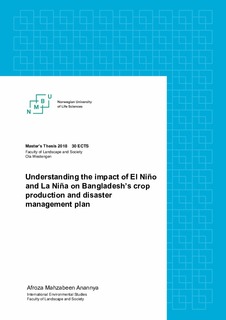| dc.description.abstract | ENSO is a natural phenomenon which creates climate anomalies around the world. And this has linked with extreme disaster in some part of the world. This climatic anomalies and extreme disaster events have an impact on agricultural production. Based on it, this study focuses on ENSO impact on crop production and its integration in disaster management of Bangladesh. Following a mixed methods approach, quantitative data on ENSO, rainfall, temperature and agricultural production and key informant interviews (KII) data were analyzed to pursue two objectives, to determine the impact of ENSO on the production of major crops (the three major types of rice, wheat, and potato) and to understand the perception and integration of ENSO in Bangladesh’s disaster policies and management plan. The statistical analysis did not identify any impact of ENSO on any of the five crops, but it indicated that all the crops have a significant positive correlation with average maximum temperature whereas rainfall does not show any significance for crop production. KII or expert opinion reflects that ENSO is considered as a cause of natural disasters in Bangladesh, but no policies or early preparedness plan address issues related to ENSO. As Bangladesh prioritizes climate change as the main concern over natural climate variability, ENSO induced climate variability gains less focus. The dearth of research on the impact of ENSO in Bangladesh is likely one of the reasons for its absence in policies and disaster management plans. Though, the statistical analysis does not identify a link, from the experts’ opinion it reflects that there might be a connection with disasters such as flood or drought. So, further research on ENSO impact on agricultural production can deliver a solution for early preparedness. Future studies can control the effect of fertilizer, irrigation, and mechanization on crop production and identify the impact of ENSO. | nb_NO |

